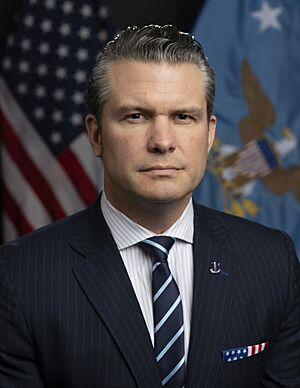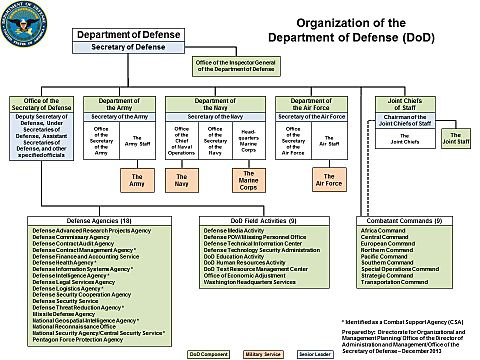United States Secretary of Defense facts for kids
Quick facts for kids United States Secretary of Defense |
|
|---|---|

|
|

Seal of the department
|
|
| United States Department of Defense Office of the Secretary of Defense |
|
| Style | Mr. Secretary (informal) The Honorable (formal) |
| Abbreviation | SecDef |
| Member of | Cabinet National Security Council |
| Reports to | President of the United States |
| Seat | The Pentagon, Arlington County, Virginia |
| Appointer | The president
with Senate advice and consent
|
| Term length | No fixed term |
| Constituting instrument | 10 U.S.C. § 113 |
| Precursor | Secretary of War Secretary of the Navy |
| Formation | September 17, 1947 |
| First holder | James Forrestal |
| Succession | Sixth |
| Deputy | Deputy Secretary of Defense |
| Salary | Executive Schedule, level I |
The United States Secretary of Defense (often called SecDef) is the leader of the United States Department of Defense (DoD). This department manages the U.S. Armed Forces. The Secretary of Defense is a very important member of the President's Cabinet.
This person's power over the military is second only to the President. The President is the Commander-in-Chief of the military. In many other countries, this job is called a "defense minister." The President chooses the Secretary of Defense. The Senate must then agree with the choice. By law, the Secretary of Defense is also part of the National Security Council.
To make sure civilians control the military, U.S. law has a special rule. The Secretary of Defense cannot have been an active military officer in the seven years before taking the job. For generals and admirals, this period is ten years. However, Congress can make an exception to this rule. This has happened three times for George C. Marshall Jr., James N. Mattis, and Lloyd J. Austin III.
The Secretary of Defense follows the President's orders. They are in charge of all parts of the Department of Defense. This includes the Army, Marine Corps, Navy, Air Force, and Space Force. The Coast Guard also falls under their command when it works with the Department of Defense.
Only the Secretary of Defense (or the President or Congress) can move forces between the different military departments. These departments are the Department of the Army, the Navy, and the Air Force. They also manage the eleven Unified Combatant Commands. Because the Secretary of Defense has so much power, some people call them the "deputy commander-in-chief." The chairman of the Joint Chiefs of Staff gives military advice to the Secretary and the President. But the Chairman is not directly in the chain of command.
The Secretary of Defense is one of the four most important Cabinet members. The others are the Secretary of State, the Secretary of the Treasury, and the Attorney General. These jobs are important because their departments are very large and have big responsibilities.
The current Secretary of Defense is Pete Hegseth. President Donald Trump chose him for the job. The Senate approved him on January 25, 2025.
Contents
How the Job Started

The Army, Navy, and Marine Corps were created in 1775. This was during the American Revolution. The War Department was set up in 1789. It was led by the Secretary of War. This department was in charge of both the Army and Navy. Later, in 1798, a separate Department of the Navy was created.
After World War II, people wanted to manage the military better. The Army wanted more central control. The Navy preferred to keep things separate. The National Security Act of 1947 was a compromise. It changed the name of the War Department to the Department of the Army. It also added the Army and Navy departments to a new group called the National Military Establishment (NME). The act also made the United States Air Force its own branch, separate from the Army.
The new leader of the NME was called the Secretary of Defense. At first, each military branch still had its own secretary in the Cabinet. The first Secretary of Defense was James Forrestal. He had been the Secretary of the Navy and didn't want this new job. He found it hard to control the other branches because his office had limited power.
To fix this, the National Security Act was changed in 1949. This change brought the military branches closer together. It helped reduce competition between them. The secretaries of the Army, Navy, and Air Force now reported directly to the Secretary of Defense. The National Military Establishment was renamed the Department of Defense. This made it one big Executive Department. The job of Deputy Secretary of Defense was also created then. This person is the second-in-command.
Since 1949, the Department of Defense has become more centralized. This means more power has gone to civilian leaders and defense-wide groups. The last big change to the rules was the Goldwater–Nichols Department of Defense Reorganization Act of 1986. This act made it more important for officers to serve in different branches. It became almost a requirement for high-ranking officers.
As mentioned, the Secretary of Defense is a civilian. This means they are not an active military member. A secretary must have been retired from military service for at least seven years. Congress can waive this rule. This has only happened three times since 1947. It happened for Army General George Marshall in 1950, Marine Corps General Jim Mattis in 2017, and retired Army General Lloyd Austin in 2021.
What the Secretary of Defense Does
The Secretary of Defense is chosen by the President. The Senate must agree with the choice. By law, the Secretary is the head of the Department of Defense. They are the President's main helper for all defense matters. They have "authority, direction and control" over the entire department. The power of the Secretary comes from the Constitution. The Constitution gives military power to Congress and the President. Since they can't handle every detail, the Secretary of Defense and their team manage military matters.
As the head of the DoD, all officials, employees, and service members work "under" the Secretary of Defense. Some of the high-ranking officials include the secretaries of the Army, Navy, and Air Force. It also includes the chiefs of staff for each military branch. All these important jobs need Senate approval.
The Department of Defense includes many parts. These are the Office of the Secretary of Defense (OSD), the Joint Chiefs of Staff (JCS), and the Joint Staff (JS). It also has the Inspector General's Office. The Combatant Commands are also part of it. The military departments (Army, Navy, Air Force) are included too. There are also many Defense Agencies and other groups.
A document called Department of Defense Directive 5100.01 explains how the department is organized. It describes the main jobs of the department. The most recent version was signed in December 2010.
The Secretary's Office
The Secretary's main civilian staff is called the Office of the Secretary of Defense (OSD). It includes the Deputy Secretary of Defense. There are also six under secretaries who handle different areas. These areas include buying equipment, research, money, intelligence, personnel, and policy. Many assistant secretaries and other directors also work here. The Secretary of Defense uses the Office of the Secretary of Defense to create the National Defense Strategy. This is a very important policy document.
The main military staff is called the Joint Staff (JS). It works under the chairman of the Joint Chiefs of Staff.
Awards and Honors
The Secretary of Defense gives out several awards to military personnel. These include the Defense Distinguished Service Medal (DDSM) and the Defense Superior Service Medal (DSSM). Other awards are the Defense Meritorious Service Medal (DMSM), the Joint Service Commendation Medal (JSCM), and the Joint Service Achievement Medal (JSAM). These are for service in joint duty assignments. The Joint Meritorious Unit Award (JMUA) is given to joint DoD groups.
The DDSM is the highest award given by the Secretary of Defense. Only the Secretary can approve it. Other awards can be approved by lower-ranking officials.
Recommendations for the Medal of Honor (MOH) go through the Secretary of Defense. The military department and the chairman of the Joint Chiefs of Staff must first support the recommendation. The Secretary of Defense must approve it before it goes to the President. The President is the final approver for the Medal of Honor.
The Secretary of Defense also approves the wearing of NATO medals. This is done with the agreement of the Secretary of State. These medals are given by the NATO Secretary General. They honor U.S. service members who meet NATO's requirements.
Working with Congress
As the head of the Department of Defense, the Secretary of Defense is the main person who talks to Congress. They speak to committees that watch over the department. The most important committees are the Senate Armed Services Committee (SASC) and the House Armed Services Committee (HASC). There are also the Senate Appropriations Committee and the House Appropriations Committee. These committees decide how much money the department gets.
For intelligence programs, the Senate Select Committee on Intelligence and the House Permanent Select Committee on Intelligence are in charge.
Role in National Security
The Secretary of Defense is a required member of the National Security Council. They attend meetings with other important leaders. These include the Vice President, the Secretary of State, and the National Security Advisor. They help prepare and coordinate important issues. These issues are then brought to the full National Security Council meetings, led by the President.
Role in Military Justice
The Secretary of Defense is one of a few civilians who can act as a "convening authority" in the military justice system. This means they can start General Courts-Martial, Special Courts-Martial, and Summary Courts-Martial. The other civilians with this power are the President, the secretaries of the Army, Navy, and Air Force, and the Secretary of Homeland Security (when the Coast Guard is under their department).
Salary
The Secretary of Defense earns a salary of US$246,400 per year. This is a Level I position in the Executive Schedule.
List of Secretaries of Defense
The person who served the longest as Secretary of Defense is Robert McNamara. He served for 7 years and 39 days. Donald Rumsfeld served the second longest, with two terms that added up to just ten days less than McNamara. The second-longest continuous term was by Caspar Weinberger, who served for 6 years and 306 days.
The shortest-serving Secretary of Defense was Elliot Richardson. He served for 114 days. He then became the U.S. Attorney General during the Watergate Scandal.
Before 1947, the military was managed by the Secretaries of the Navy and Secretaries of War.
- Parties
Democratic Republican Independent / Unknown
- Status
Denotes an acting secretary of defense
| No. | Image | Name | Start | End | Duration | Party | Home State | President(s) | ||
|---|---|---|---|---|---|---|---|---|---|---|
| 1 |  |
James Forrestal | September 17, 1947 | March 28, 1949 | 1 year, 192 days | Democratic | Harry S. Truman (1945–1953) |
|||
| 2 |  |
Louis A. Johnson | March 28, 1949 | September 19, 1950 | 1 year, 175 days | Democratic | ||||
| 3 |  |
George C. Marshall | September 21, 1950 | September 12, 1951 | 356 days | Independent | ||||
| 4 |  |
Robert A. Lovett | September 17, 1951 | January 20, 1953 | 1 year, 125 days | Republican | ||||
| 5 |  |
Charles Erwin Wilson | January 28, 1953 | October 8, 1957 | 4 years, 253 days | Republican | Dwight D. Eisenhower (1953–1961) |
|||
| 6 |  |
Neil H. McElroy | October 9, 1957 | December 1, 1959 | 2 years, 53 days | Republican | ||||
| 7 |  |
Thomas S. Gates Jr. | December 2, 1959 | January 20, 1961 | 1 year, 49 days | Republican | ||||
| 8 |  |
Robert McNamara | January 21, 1961 | February 29, 1968 | 7 years, 39 days | Republican | John F. Kennedy (1961–1963) |
|||
| Lyndon B. Johnson (1963–1969) |
||||||||||
| 9 |  |
Clark Clifford | March 1, 1968 | January 20, 1969 | 325 days | Democratic | Lyndon B. Johnson (1963–1969) |
|||
| 10 |  |
Melvin Laird | January 22, 1969 | January 29, 1973 | 4 years, 7 days | Republican | Richard Nixon (1969–1974) |
|||
| 11 |  |
Elliot Richardson | January 30, 1973 | May 24, 1973 | 114 days | Republican | ||||
| – |  |
Bill Clements Acting |
May 24, 1973 | July 2, 1973 | 39 days | Republican | ||||
| 12 |  |
James R. Schlesinger | July 2, 1973 | November 19, 1975 | 2 years, 140 days | Republican | Richard Nixon (1969–1974) |
|||
| Gerald Ford (1974–1977) |
||||||||||
| 13 |  |
Donald Rumsfeld | November 20, 1975 | January 20, 1977 | 1 year, 61 days | Republican | Gerald Ford (1974–1977) |
|||
| 14 |  |
Harold Brown | January 20, 1977 | January 20, 1981 | 4 years, 0 days | Democratic | Jimmy Carter (1977–1981) |
|||
| 15 |  |
Caspar Weinberger | January 21, 1981 | November 23, 1987 | 6 years, 306 days | Republican | Ronald Reagan (1981–1989) |
|||
| 16 |  |
Frank Carlucci | November 23, 1987 | January 20, 1989 | 1 year, 58 days | Republican | ||||
| – |  |
William Howard Taft IV Acting |
January 20, 1989 | March 21, 1989 | 60 days | Republican | George H. W. Bush (1989–1993) |
|||
| 17 |  |
Dick Cheney | March 21, 1989 | January 20, 1993 | 3 years, 305 days | Republican | ||||
| 18 |  |
Les Aspin | January 20, 1993 | February 3, 1994 | 1 year, 14 days | Democratic | Bill Clinton (1993–2001) |
|||
| 19 |  |
William Perry | February 3, 1994 | January 24, 1997 | 2 years, 356 days | Democratic | ||||
| 20 |  |
William Cohen | January 24, 1997 | January 20, 2001 | 3 years, 362 days | Republican | ||||
| 21 |  |
Donald Rumsfeld | January 20, 2001 | December 18, 2006 | 5 years, 332 days (7 years, 29 days total) |
Republican | George W. Bush (2001–2009) |
|||
| 22 |  |
Robert Gates | December 18, 2006 | June 30, 2011 | 4 years, 194 days | Republican | George W. Bush (2001–2009) |
|||
| Barack Obama (2009–2017) |
||||||||||
| 23 |  |
Leon Panetta | July 1, 2011 | February 26, 2013 | 1 year, 240 days | Democratic | Barack Obama (2009–2017) |
|||
| 24 |  |
Chuck Hagel | February 27, 2013 | February 17, 2015 | 1 year, 355 days | Republican | ||||
| 25 |  |
Ash Carter | February 17, 2015 | January 20, 2017 | 1 year, 338 days | Democratic | ||||
| 26 |  |
Jim Mattis | January 20, 2017 | January 1, 2019 | 1 year, 345 days | Independent | Donald Trump (2017–2021) |
|||
| – |  |
Patrick M. Shanahan Acting |
January 1, 2019 | June 23, 2019 | 173 days | Independent | ||||
| – |  |
Mark Esper Acting |
June 24, 2019 | July 15, 2019 | 21 days | Republican | ||||
| – |  |
Richard V. Spencer Acting |
July 15, 2019 | July 23, 2019 | 8 days | Republican | ||||
| 27 |  |
Mark Esper | July 23, 2019 | November 9, 2020 | 1 year, 109 days | Republican | ||||
| – |  |
Christopher C. Miller Acting |
November 9, 2020 | January 20, 2021 | 72 days | Republican | ||||
| – |  |
David Norquist Acting |
January 20, 2021 | January 22, 2021 | 2 days | Republican | Joe Biden (2021–2025) |
|||
| 28 |  |
Lloyd Austin | January 22, 2021 | January 20, 2025 | 3 years, 364 days | Independent | ||||
| – |  |
Robert G. Salesses Acting |
January 20, 2025 | January 25, 2025 | 5 days | Independent | Donald Trump (2025–present) |
|||
| 29 |  |
Pete Hegseth | January 25, 2025 | Incumbent | 320 days | Republican | ||||
Who Takes Over the Job
Presidential Succession
The Secretary of Defense is sixth in line to become President. This is called the presidential line of succession. They follow the Secretary of the Treasury. They come before the Attorney General.
Secretary's Succession
On December 10, 2020, President Donald Trump changed the order of who takes over if the Secretary of Defense cannot do their job. This order is:
| # | Office |
|---|---|
| 1 | Deputy Secretary of Defense |
| 2* | Secretary of the Army Secretary of the Navy Secretary of the Air Force |
| 3 | Under Secretary of Defense for Policy |
| 4 | Under Secretary of Defense for Intelligence and Security |
| 5 | Under Secretary of Defense for Acquisition and Sustainment |
| 6 | Under Secretary of Defense for Research and Engineering |
| 7 | Under Secretary of Defense (Comptroller) |
| 8 | Under Secretary of Defense for Personnel and Readiness |
| 9 | Deputy Under Secretary of Defense for Policy |
| 10 | Deputy Under Secretary of Defense for Intelligence and Security |
| 11 | Deputy Under Secretary of Defense for Acquisition and Sustainment |
| 12 | Deputy Under Secretary of Defense for Research and Engineering |
| 13 | Deputy Under Secretary of Defense (Comptroller) |
| 14 | Deputy Under Secretary of Defense for Personnel and Readiness |
| 15* | General Counsel of the Department of Defense Assistant Secretaries of Defense Director of Cost Assessment and Program Evaluation Director of Operational Test and Evaluation Chief Information Officer of the Department of Defense |
| 16* | Under Secretary of the Army Under Secretary of the Navy Under Secretary of the Air Force |
| 17* | Assistant Secretaries of the Army Assistant Secretaries of the Navy Assistant Secretaries of the Air Force General Counsel of the Army General Counsel of the Navy General Counsel of the Air Force |
| *Order of Succession is determined by the seniority of officials in their role. |
Related Topics
- Base Realignment and Closure Commission
- Boeing E-4
- Challenge coin
- Continuity of Operations Plan
- Defense Policy Board Advisory Committee
- Defense Support of Civil authorities
- Designated survivor
- Emergency Action Message
- Global Command and Control System
- Gold Codes
- Key West Agreement
- Military operation plan
- National Command Authority (United States)
- National Industrial Security Program
- National Security Strategy (United States)
- Office of the Secretary of Defense Identification Badge
- Packard Commission
- Permissive Action Link
- Presidential Successor Support System
- Quadrennial Defense Review
- Rules of engagement
- Secretary of Defense Employer Support Freedom Award
- Single Integrated Operational Plan
- State secrets privilege
- Stop-loss policy
- Two-man rule
- Unconventional warfare (United States Department of Defense doctrine)
- United States Foreign Military Financing
- US Commission on National Security/21st Century
See also
 In Spanish: Secretario de Defensa de los Estados Unidos para niños
In Spanish: Secretario de Defensa de los Estados Unidos para niños



